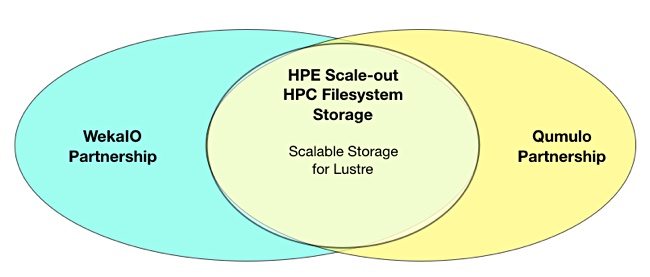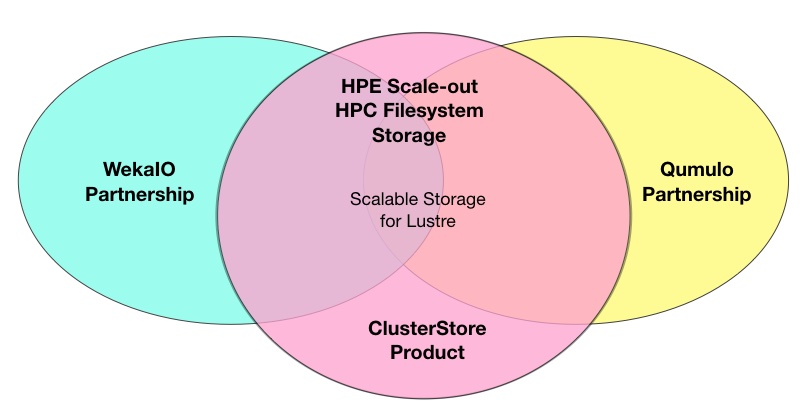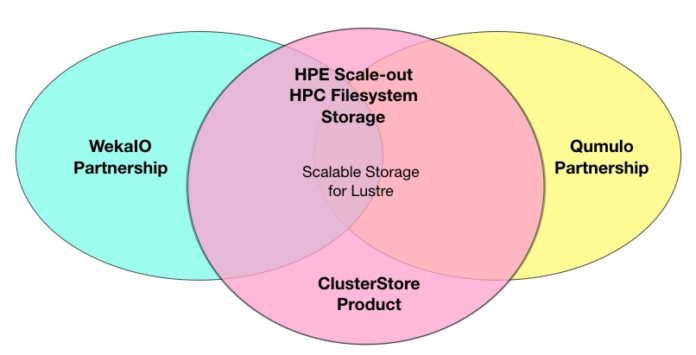By buying Cray HPE acquires a set of supercomputer, storage and interconnect hardware and software products that it will integrate with existing product lines.
We asked HPE about its HPC product positioning post-Cray and a spokesperson said: “We’ll make those decisions as we move through the integration process after the deal closes [in December 2018]. What I can confirm now is that the entire Cray business and all of its functions will become part of HPE and will be combined with our current HPC business.”
So what will that mean for HPE’s HPC storage line up whenCray’s ClusterStor is under its wing?
Post acquisition, HPE can offer its customers four scale-out, parallel file system product choices for high-performance computing (HPC). Or perhaps one or more product lines will face the chop.
Today HPE sells three scale-out, parallel access file storage product ranges: its own Scalable Storage for Lustre and third-party offerings fromQumulo and WekaIO. Here is a brief overview at each product.

Scalable Storage for Lustre
This is the Lustre file system software, with ZFS RAID software, based on Object Storage Servers and Metadata Servers. The software runs on HPE ProLiant DL360 and DL380 Gen10 servers, with D3710 Enclosure, MSA 2050 SAN Storage for metadata storage, and D6020 Disk Enclosure for capacity storage.
An HPE Version of Community Lustre is provided, featuring the ZFS file system for data integrity, data compression, and file system snapshots. Lustre is also POSIX-compliant.
Qumulo Core
Qumulo provides three kinds of nodes to deliver its Core software: high-performance, hybrid capacity, and nearline archive. Core is also available on AWS and the Google Cloud Platform.
Core supports trillions of files, mainstream NFS and SMB file access protocols, and supports S3 via Minio.
A CIO in the life sciences industry told us: “We have been talking to Qumulo since they were still in stealth. Honestly I think it is a good platform for scale-out, and if we weren’t committed to Isilon we would be really looking hard at them, but I don’t see enough of a difference between this and Isilon to justify the migration.
“I am not sure if they would be picked up by HPE as an Isilon competitor or if HPE would just see that scale-out market as too limited. I do know Dell Technologies has been very successful selling Isilon in a variety of use cases; not sure how much bigger that market is.”
WekaIO Matrix
This is a high-performance product with SPEC SFS 2014 benchmark wins and near-Summit supercomputer storage performance. It runs in AWS and has an S3 gateway. Like Qumulo, WekaIO supports NFS and SMB plus HDFS as well, and is POSIX-compliant.
That means it supports APIs, command line shells and utility interfaces found in Unix-style operating systems. It also utilises NVMe-oF for fast access to storage nodes.
Our CIO source said: “Weka [is] the most technically advanced storage solution. We have tested it pretty extensively and it is very performant as it scales; definitely a new generation of filesystem that is equally at home in the cloud and on-premises.”
He added: “I would not be surprised to see HPE gobble them up as it seems that is their strongest large partner, but one never knows if AWS or Azure might have interest. We have not purchased any of this storage at this stage but they are definitely on the short list of technologies.”
ClusterStor
These three products all overlap to some extent with Cray’s ClusterStor systems which have been sold in Cray HPC and supercomputing sites. ClusterStor is based on Lustre and comes with L300N disk and L300F all-flash arrays. It does not support NFS, SMB or the HDFS protocol, and is POSIX-compliant. The software runs in Azure.
Our CIO said: “ClusterStor [is a] good Lustre solution, great for niche HPC application, limited utility in the enterprise, not a real growth market as Lustre is still seen as esoteric by most enterprise shops.”
Our read
Blocks & Files thinks that ClusterStor will, over time, replace Scalable Storage for Lustre There could possibly be an importation of the ZFS features from Scalable Storage for Lustre into ClusterStor.

We also think that HPE will likely lead with ClusterStor – rather than Qumulo – in HPC opportunities needing hardware and software, as it can capture more of the customer spend for itself.
ClusterStor will also win out over Qumulo when Azure compatibility is needed but lose when AWS, S3 or GCP support is needed. Naturally ClusterStor will be preferred when the storage is part of a Cray compute bid.
However Qumulo has tiered hardware and that could swing bids in its favour. It may be that ClusterStor outperforms Qumulo but that will need testing.
We think Qumulo and ClusterStor performance will be be roughly similar whereas WekaIO’s Matrix is faster, given the benchmark evidence. Unless there is a clear need for WekaIO’s performance and/or AWS support, its opportunities within the HPE market could well be limited by ClusterStor.
To conclude, ClusterStor is bad news for Scalable Storage for Lustre and a cuckoo in the HPE nest for Qumulo and WekaIO.








